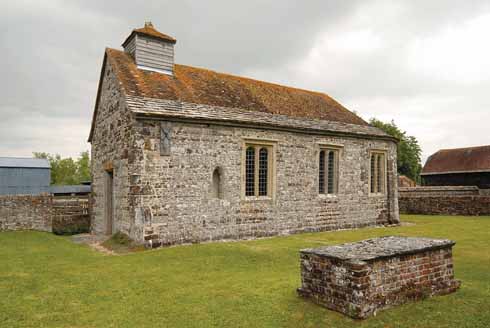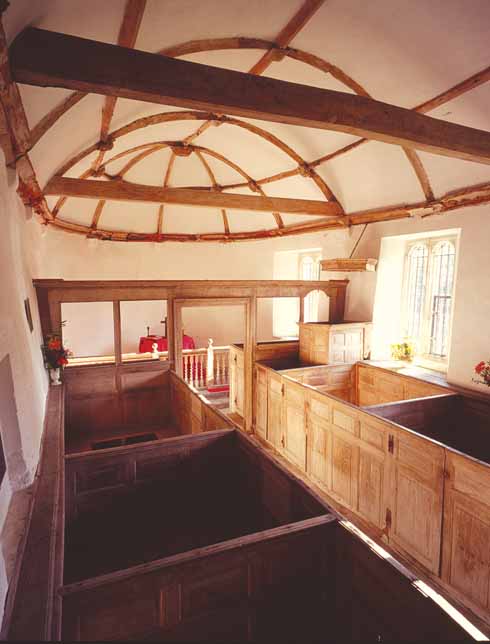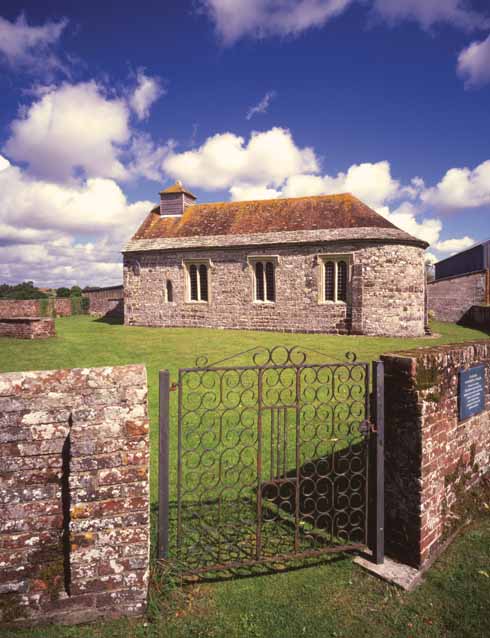Bats in the bell-cote – St Andrew’s, Winterborne Tomson
Steve White looks at the recent restoration of St Andrew’s Church, Winterborne Tomson – a favourite church of Thomas Hardy and a Dorset gem
Published in June ’13
St Andrew’s church sits lightly in the hamlet of Winterborne Tomson, next to farm buildings and close to a beautiful manor house. The charming single-cell Norman church has an apsidal east end – the end wall curves, as does the roof; it is the only one of its type in Dorset and one of only four in England.
It has essentially remained unaltered in plan since the early 12th century, suggesting that the local population has always been a small one. It does not look like an ecclesiastical building in the conventional sense – it is only the tiny, weather-boarded bell-cote that gives any clue to its purpose. This bell-cote houses one bell, dated 1668, which is thought to have been cast by Anthony Bartlet of Whitechapel.
Thanks to its small congregation (even in the 19th century not many people lived nearby… and there was another small church just across the fields in Anderson), St Andrew’s was not considered worthy of the Victorian ‘restoration’, unlike many other Dorset churches.
The church’s history is a fascinating one; William Wake, 1657-1737, was born locally and had close associations with the church – his father had bought the Winterborne Tomson estate from the Hussey family in the late 1600s. Wake was Archbishop of Canterbury from 1716 until his death and it is said that he would sometimes turn up unexpectedly to conduct services at St Andrews, much to the consternation of the regular incumbent. Archbishop Wake paid for the complete refitting of the internal furniture of the church – box pews, pulpit, screen etc – all made in oak. Bleached by use and by time, they have a wonderful patina and still survive to this day.
That the internal furniture has survived is something of a miracle when one becomes aware of the condition of the church in the early 1900s. Sir Frederick Treves wrote in Highways and Byways in Dorset in 1906: ‘The poor little sanctuary has long been deserted; the windows are broken, and birds roost on the pews or under the cove roof…while everywhere is the taint of mould and the dank odour of decay.’
Other sources from the time tell of farm animals using the church for shelter and the church and the churchyard being, in effect an extension of the farm.
By the 1920s the building was close to dereliction, the softwood floors of the pews had all but rotted away and the window glass had gone. Clearly, if something hadn’t been done, and as a matter of urgency, then the building would have been lost forever.
AR Powys was one of the famous Powys brothers, but was, and still is, largely overshadowed by Theodore, John Cowper and Llewelyn, his famous literary siblings. An accomplished architect, Powys was secretary of the Society for the Protection of Ancient Buildings (SPAB) for 25 years and, in 1929, SPAB decided to repair St Andrew’s church and return it to religious use.

Without the tell-tale bell-cote, one would not realise this was a church from the outside (image: David Bailey)
Powys was clearly a very progressive individual from an architectural perspective; rather than simply rip out the old timbers and replace with new, new timbers were laid alongside old. Whilst new clear glass was made for the church, it was fitted into the original iron saddle bars. Furthermore, repairs were carried out to fragile parts of the fabric, such as roof bosses, which were carefully and meticulously restored rather than replaced.
Thomas Hardy had been very fond of this church and had been a member of SPAB for 47 years; the society had access to a collection of his architectural manuscripts which, with the permission of the author’s wife, were sold for £1000 to raise the money required for the conservation work to be carried out. More than half of this sum went towards repairs to St Andrew’s. In recognition of this, one of the replacement oak laths fitted by Powys is marked ‘THOMAS HARDY 1930’. The project was budgeted at £250 but cost three times this estimate, the remainder was provided by Lionel Brett Lord Esher (who became the 4th Viscount Esher upon the death of his father in 1963), himself an architect and town planner of some note, as well as a long-term chairman of SPAB.

Once the tiles were stripped, a rather worrying sight was revealed (image: Churches Conservation Trust)
In 1936, Alfred was the second of the eleven Powys siblings to die, at the age of 55. He is buried in the churchyard of St Andrew’s, alongside his wife. When asked why he had chosen to be buried in this particular place, his grandson, Stephen Powys-Marks replied that the fate of the church at Winterborne Tomson ‘was so closely dependent on what he did’, that he almost certainly found some kind of affinity with the place. There is a marker – a simple stone – to commemorate Powys, by George Churchill. A more elaborate memorial was carved by Reynolds Stone at the request of Powys’s widow, Faith, in 1962. Stone, a famous carver in various materials, spent many years living in the Old Rectory, Litton Cheney in Dorset and it was he who was commissioned to carve Winston Churchill’s memorial in Westminster Abbey.
Rededicated on 8 May 1932 by Dr G B Allen, Bishop of Sherborne, the church has been used for services regularly since, although these now tend to be restricted to Advent, Whitsun and Harvest Thanksgiving.
St Andrew’s has been in the care of the Churches Conservation Trust (CCT) since March 1974 and, in that time, the trust has overseen a number of conservation schemes on the structure. In the last 10 years, just prior to the most recent work, a project was undertaken on some of the internal woodwork, especially the bosses decorating the roof beams. Deathwatch beetle had been responsible for a good deal of damage, which needed careful repair. The most recent work, however, has been the most important since the Powys restoration and was begun in October 2011 and completed in May 2012. The need to do something had become imperative as roof tiles were beginning to deteriorate and letting in water, leading to the risk that the timber roof structure was in danger of collapse.
![613EdWInterborneTomson3_Roof work March 2012 NR[1]](https://www.dorsetlife.co.uk/wp-content/uploads/2013/06/613EdWInterborneTomson3_Roof-work-March-2012-NR1.jpg)
The roof's wooden members needed a good deal of work to ensure it did not collapse (image: Churches Conservation Trust)
The project was carried out under the instruction of the Churches Conservation Trust; Philip Hughes associates were the architects and Magenta Conservation the contractor. It involved almost completely covering the building in scaffolding and polythene sheeting, to keep the worst of the weather out. Work could not take place in the dryer months of the year owing to the resident bat colony in the bell-cote.
The job required that each roof tile be carefully removed (they were put back as they had been found), and damaged woodwork repaired or replaced. The bell-cote weather-boarding was also renewed. A bituminous membrane found under the tiles was responsible, in part, for the deathwatch beetle problem, as the beetles like the damp conditions it unintentionally provided; a newly fitted vapour permeable membrane should prevent damp being a problem in future.
Some clay pipes from the 1920s (probably those discarded by the Powys team) were discovered in the roof space, as was a dated acknowledgement of the work done by AR Powys. The roof beams fitted by Powys, including the beam inscribed to Thomas Hardy, were found to be in excellent condition and hopefully will now remain so.
The total cost of the conservation work was £71,350 which was funded by the CCT, apart from a donation of £2000 from SPAB’s ‘Hardy Fund’; this fund still exists and so it is fitting that Thomas Hardy’s legacy remains and he is still financing repairs to the church of which he was so fond. SPAB go to great pains to emphasise that they do not sanction ‘renovations’, but are keen to use their funds to support the ‘repair’ of old buildings, as has happened with St Andrew’s.
The result of this conservation work is a church that will be open to the public 365 days of the year for decades to come. A visit would be worthwhile from a financial perspective to the CCT; they are desperately in need of donations for this type of work and, as well as putting money in the wall-safe, buying a membership of either the CCT or SPAB would be very welcome.
A journey to Winterborne Tomson will be rewarding to the visitor too. This is a church worth visiting – Hardy and Powys loved the building with good reason, so why not go and take a look for yourself? The building doesn’t appear any different after this conservation project, than it did before; Wake, Hardy, Powys and indeed all of Dorset should find this very reassuring.
• Visit www.spab.org.uk or www.visitchurches.org.uk for details of the vital work of the organisations mentioned in this feature.





